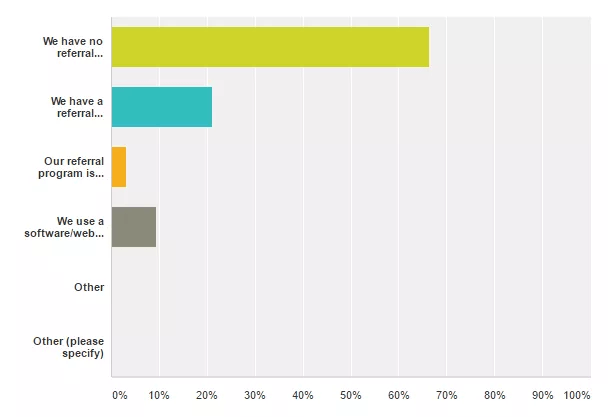How to Set Up a Referral Marketing Program That Actually Works

82% of Americans say that they look to recommendations from friends and family first when making a purchase. So, naturally, many businesses use referrals as a measure of success.
If you're making your customers happy and delivering great products and services to the market, referrals will naturally follow, right?
By that logic, if you're not getting referrals automatically, then there must be something wrong with your product.
Not necessarily.
While the value of customer satisfaction and delivering exceptional experiences can't be ignored, most referral programs don't happen on their own.
Successful programs are built with intention and nurtured with intensity.
Referral marketing is the unsung hero of digital marketing, but you need to know what pitfalls to avoid to ensure that your hard work pays off and your program doesn't fizzle out. The problem is that nearly two-thirds of businesses either don't have a referral marketing program in place or don't know how to maximize its value if they do.
Follow these simple steps and your referral marketing program will grow like hungry little weeds if you feed and water them regularly.
What makes a referral program successful?
Word of mouth is one of the most powerful tools in marketing.
As Mark Zuckerberg puts it: "People influence people. Nothing influences people more than a recommendation from a trusted friend. A trusted referral influences people more than the best broadcast message. A trusted referral is the Holy Grail of advertising."
74% of consumers name referrals as one of the most influential factors in their purchasing decisions.
Think about it: when you look for a new product or service, what is one of the first things you do?
You ask friends for recommendations and check out reviews.
So how exactly does a referral marketing program help get the word out about your brand?
On average, the Customer Lifetime Value (CLV) of a referred customer is two times higher than a non-referred customer.
If the results are so remarkable, then why aren't more businesses using referral marketing?
Often, it's a simple matter of planning.
Many organizations make the mistake of throwing a passive referral strategy against the wall to see if it sticks. When it doesn't, they give up on referral marketing and invest their time and energy elsewhere.
Referral marketing is one of the most effective tools in a marketer's toolbox, but it takes careful planning and hard work. In general:
- A good place to start is to see what worked well for others in similar industries or with similar business models.
- You should periodically reevaluate how your program is performing and make changes when needed. Referral programs require ongoing attention and cultivation, or they'll wither and die.
Ready to get started? Here are some proven ways to build an effective referral marketing program that will help crush your revenue goals and build long-term growth.
Ask for what you want
Referrals won't come to you. You have to ask for them.
Unfortunately, many organizations don't know when or how to ask, so their referral program never gets off the ground.
Remember that everyone benefits from referrals--not just the vendor. Consumers seek out and value recommendations.
Be persistent. If you get shot down the first time you ask, keep trying.
Use it as a learning opportunity to ask what you can do to provide a better experience and earn their recommendation.
Salesmate has secured over 1500 referral partners by confidently asking for what they want with their referral recruitment page.
If you want to follow their lead, you'll need a few basic tools to get started.
- CRMs are your best friend. Not only do they keep contact information for all of your potential referrals in one place, but you can also group referral targets, track communications and easily keep up as your program grows.
- Take time to build some repeatable processes and templates.You don't have time to reinvent the wheel every time you want to reach out to a new business or group.Have a framework in place before you launch.Don't forget about signup pages, reminder emails and an easy way for your referrals to share details with their network.
- Don't rule out affiliate marketing as an extension of your program.What's the difference between affiliates and referrals?Affiliates usually don't make 1:1, personal recommendations, while referrals typically leverage personal relationships. Both drive customer growth and higher revenue, so don't be shy about using affiliates too.
Check out this example of how affiliate marketing helped Poster Gully grow their marketplace from zero to $1m in only five years.
Dig a deeper pool
You can't fake referrals--you need to build a tribe of loyal users or potential buyers will assume you aren't an established brand and they won't trust you.
Most cold email outreach fails because it's incredibly challenging to get the attention of the consumer.
Your message, brilliant as it may be, is just one of a hundred messages and gets lost in the crowd.
Referrals change the game.
42% of online shoppers trust the opinions of their peers over almost anything else--and trust is what helps you cut through the noise.
Think of your industry like one big app store.
You wouldn't download an app with one star or terrible reviews, would you?
No. You would keep scrolling until you found an app with great reviews from happy users.
Now, compare that to your business.
If getting more positive reviews is the single-biggest way to increase app downloads, then building a referral network is a fast track to more conversions.
When you're ready to start gathering referrals, be careful how you cast your net; do some research to find the right types of customers and affiliates.
Make sure your plan is fully-baked before you even contact your first customer. Set specific, measurable goals and craft a consistent message.
The next step is to choose the right incentives, and frame them the right way.
Use your incentives to get attention Consider the Rule of 100.
It means that if you have to choose between a fixed discount or a percentage, choose the "bigger number" for maximum impact. In the example above, $10 is a bigger discount in reality, but it doesn't have the same immediate impact as "40% off."
Once you know what you're going to offer, decide how you will collect and track activities within your referral network. Know how will you measure the success of your program.
Look at this example from Dropbox. They went from 100,000 users to over 4 million in only 15 months.
As tempting as it may be, don't assume a cash award is your best bet. Remember how successful Dropbox was with their referral program and experiment with free content, gamification or free product, like this example from Sock Fancy:
Find the right tools.
There are plenty of referral marketing tools to choose from, but why do you even need one?
Simple: growth.
As your business grows and you gain referrals, it will be tough to keep up with manual processes.
Still not convinced? Start with one tool to test the waters like online activewear retailer Rhone did with their referral program. They used Referral Candy to push automated referral requests to customers and saw an $80k lift in sales as a result.
How do you do the same thing?
It's time to automate.
Automated referral programs not only drive revenue now, but also in the future.
Here's a great example: Typeform, a B2B SaaS company that provides form-building services, used Referral Sasquatch to automate their referral program. Post-automation, they saw a bump of 10% in annual paid growth.
Customers who find you via an automated referral program have a 16% higher LTV than those who don't. And 69% of companies with referral marketing programs in place find that their time to close with new customers is faster than those without.
While you're scoping out resources, don't forget to look within your own walls and another underutilized referral source: employees. If your employees aren't using and talking about your solution--that's your first mission.
It is crucial to make sure that everyone in your organization is aware of the program and can direct potential referrals to a signup form. Why? Only 30% of American workers feel engaged at work. Gaining internal advocates first, who are proud to promote your brand is half the battle in gaining external referrals.
Nurture your program
Once you've launched your program, you can't just leave it on auto-pilot, or it will likely veer off course.
If your goal is to build a living, breathing chain of referrals, you need to check the strength of each link in your chain periodically.
If you don't, you'll lose momentum before you even realize it's happening.
There are a couple of easy ways to ensure that your referral program is evergreen.
- Thank new referrals immediately and deliver the promised incentive right away.Here's an example of a major referral payoff from Choose Energy.
- Don't neglect your loyal, long-term referral customers and affiliates.Check in with them periodically.
- Don't underestimate the power of the occasional, tangible surprise to continually show your appreciation.
- Set yourself up for repeat sales by offering discounts to your referrals.Everyone wins.
The bottom line is that program nurturing can make or break your referral program.
Each engaged referral invites an average of 2.68 new people to your brand. That's nearly a 3:1 ROI.
Here's the kicker (and why you can't just send one referral email and be done with it):
The average human being forgets nearly half of the new information they see after only 20 minutes. If you want to be remembered, you have to keep showing up.
Look at how Harry's, a male grooming brand, racked up over 100,000 email addresses before they even launched-- all by keeping referrals engaged and participating in new referral challenges.
They used multiple outreach channels, multiple messages, and kept building on the incentives they offered.
Be pervasive. Ask for referrals in every place your customers find you (social media, website, email, etc.)
The Final Word
No matter the industry, digital competition is fierce.
Consumers have more choices for online purchasing than ever before.
It's your job to get noticed.
Think of referral marketing as an essential pillar of your marketing strategy. Budget and plan for it like you would any other marketing program.
Successful referral marketing programs pay for themselves many times over with the revenue growth and brand recognition they reap.
Remember not to get tripped up by your own success with a program that can't grow along with you.
Make sure your referral marketing program will scale quickly and keep up with your future plans.
Likewise, don't forget to foster employee engagement with your brand and excitement about your program before you ever ask for your first referral.
Align your referral program to the right business outcomes and incentives and select a tool that is tightly aligned to your goals.
If you feed and nurture your program after you launch, and pause periodically to track progress, you'll soon be rewarded with new sales and a loyal tribe of repeat customers.
Subscribe to Our Newsletter!
Latest in Marketing








